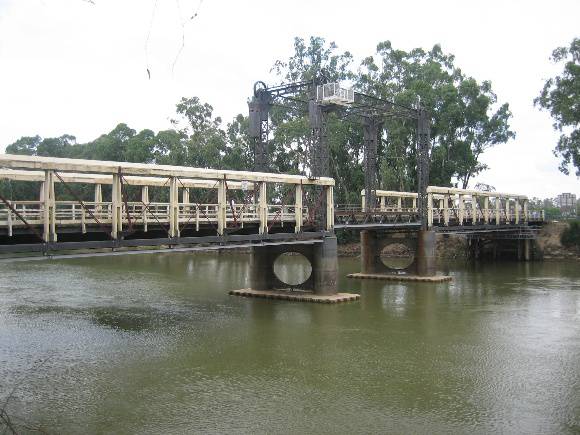| Back to search results » | Back to search page » |
|
BARHAM KOONDROOK BRIDGE
LocationKERANG-KOONDROOK ROAD KOONDROOK, GANNAWARRA SHIRE
File NumberPL-HE/03/1174LevelRegistered |
|
Statement of Significance
What is Significant? The bridge comprises of a timber bridge deck supported by two 31.7m metre long De Burgh composite truss spans each side of a 17.8 steel lift-span bridge. The lift-span is supported by four cast iron pillars filled with concrete built into two cofferdams also filled with concrete. The approach spans are 9.1m each and are constructed of round timber girders on round timber trestle piers. The raising and lowering of the bridge deck was designed to allow paddle steamers and to pass through. The cross girders on the top of the structure are unusually curved and decorated with plaques showing the construction date and the names of both New South and Victoria. The bridge timbers are tallowwood and ironbark from the northern rivers region of New South Wales, although some local river red gum was used for the decking on the minor timber spans. The northern rivers timber was used because of its superior strength and durability. Unlike the local river red gum, which has a tendency to twist and split when sawn into squared timber, ironbark retains its shape and strength. The Murray around Barham was settled by graziers, mainly from Victoria, in the 1840s. Koondrook developed in the 1870s as a service town to the Murray River paddle steamer trade and the township benefited from adjacent red-gum forests for timber in demand for railway sleepers. Trade was further advanced when a tramway was established in 1888-89 to link Koondrook with the railhead at Kerang and local agriculture was aided by the construction of an irrigation pump in 1890. Barham was settled more slowly. The connection between the two settlements was serviced by an old punt that had already been used for some time at Echuca. River crossing by punt was protracted and this hampered the ability move stock and produce from the northern bank of the Murray to the railway on the southern bank. Agitation for the construction of a bridge to replace the punt had been active since the 1890s. Commercial, pastoral and agricultural interests from on both sides of the Murray combined efforts to lobby for the construction of a bridge. Barham-Koondrook is approximately halfway between the Swan Hill and Echuca bridges and it was argued that that the Moulamein Koondrook droving route was shorter, better watered and better grassed than the routes through Swan Hill or Echuca. In addition land in the Riverina north of the Murray was considered more suited to agriculture than that around Kerang but the lack of a bridge was hindering its development making the connection with the closer Victorian markets difficult. Initially both Victorian and the New South Wales Governments were lukewarm in their response to requests for the bridge but a deputation of Victorian politicians to New South Wales in 1900 eventually succeeded in obtaining funds from New South Wales. Victoria offered to pay for half the cost of the bridge if New South Wales paid the other half. Work commenced in April 1903 and was completed 8 October 1904, making the Barham-Koondrook Bridge the twelfth bridge to cross the Murray River. The bridge directly connected the pastoral and agricultural concerns in the Wakool region of the Riverina with the Victorian railhead at Koondrook and has long been an important link in the north-south stock route connecting Victoria with the New South Wales and Queensland pastoral centres. The Barham-Koondrook Bridge is of historical significance for its associations with John Monash who was one of Australia's most important engineers, and one of the country's most famous soldiers. The Barham-Koondrook Bridge is also of historical significance for its association with the innovative and influential engineer Ernest De Burgh. The Barham-Koondrook Bridge is of historical significance for its role in facilitating intercolonial trade between New South Wales and Victoria.
Built in 1904 by Monash and Anderson to a design by New South Wales Public Works Department engineer, Ernest De Burgh, the Barham-Koondrook Bridge is a composite De Burgh truss and steel centre lift-span bridge over the Murray River between the towns of Koondrook in Victoria and Barham in New South Wales.
How is it Significant?
The Barham-Koondrook Bridge is of historical and technical (scientific) significance to the State of Victoria.
Why is it Significant?
The Barham-Koondrook Bridge is of technical (scientific) significance for the innovations used in its design and construction. The De Burgh Truss was developed by Ernest de Burgh as an improvement on the innovative Allen Truss. The bridge is a rare combination of the Percy Allan designed steel central lift-span with composite De Burg trusses. The only other Murray River bridge to have this configuration is the Cobram Bridge. Only two other were built in New South Wales, over the Paterson River at Hinton and Dunmore, west of Newcastle. No other bridges of this type were built in Victoria.
Group
Transport - Road
Category
Road Bridge








